Technical and Economic Analysis of an HVDC Transmission System for Renewable Energy Connection in Afghanistan
Abstract
:1. Introduction
2. Future Power Demand and Challenges
3. Renewable Energy Potential
4. Afghan Power Transmission System
5. HVDC vs. HVAC Transmission System
6. CSC-HVDC vs. VSC-HVDC
7. Worldwide HVDC Projects
8. Proposed Transmission Line
9. Technical Analysis
9.1. Resistive (Joule) Losses Calculation
9.1.1. The HVAC Line Loss
9.1.2. The HVDC Line Loss (Joule Loss)
9.2. Corona Losses
9.2.1. HVAC Corona Loss
9.2.2. HVDC Corona Loss
10. Economic Analysis
10.1. Investment Costs
10.2. Annual Costs
10.3. Discounted Cash Flow Method (DCF)
10.4. Results Analysis
11. Discussion
12. Conclusions and Recommendations
Author Contributions
Funding
Conflicts of Interest
References
- Ludin, G.A.; Matayoshi, H.; Danish, M.S.; Yona, A.; Senjyu, T. Hybrid PV/Wind/Diesel Based Distributed Generation for an Off-Grid Rural Village in Afghanistan. J. Energy Power Eng. 2017, 11, 85–92. [Google Scholar] [CrossRef]
- Afghanistan GDP per Capita, Trading Economics, World Bank. Available online: https://tradingeconomics.com/afghanistan/gdp-per-capita#:~:text=GDP%20per%20capita%20in%20Afghanistan%20is%20expected%20to%20reach%20570.00,according%20to%20our%20econometric%20models (accessed on 25 August 2021).
- Energy Supply Improvement Investment Program (RRP AFG 47282-001), Environmental Assessment and Review Framework ADB. Available online: https://ewsdata.rightsindevelopment.org/files/documents/01/ADB-47282-001_sxnXWzE.pdf (accessed on 25 August 2021).
- Ludin, G.A.; Amin, M.A.; Aminzay, A.; Senjyu, T. Theoretical Potential and Utilization of Renewable Energy in Afghanistan. AIMS Energy 2016, 5, 1–19. [Google Scholar] [CrossRef]
- Ludin, G.A.; Amin, M.A.; Matayoshi, H.; Rangarajan, S.S.; Hemeida, A.M.; Takahashi, H.; Senjyu, T. Solid-State DC Circuit Breakers and Their Comparison in Modular Multilevel Converter Based-HVDC Transmission System. Electronics 2021, 10, 1204. [Google Scholar] [CrossRef]
- Meah, K.; Ula, S. Comparative Evaluation of HVDC and HVAC Transmission Systems. In Proceedings of the IEEE Xplore, Power Engineering Society General Meeting 2007, Tampa, FL, USA, 24–28 June 2007; pp. 1–5. [Google Scholar] [CrossRef]
- Gul, M.; Tai, N.; Huang, W.; Nadeem, M.H.; Ahmad, M.; Yu, M. Technical and Economic Assessment of VSC-HVDC Transmission Model: A Case Study of South-Western Region in Pakistan. Electronics 2019, 8, 1305. [Google Scholar] [CrossRef] [Green Version]
- Siyal, M.A.; Maheshwari, V.K.; Memon, A.M. Techno-Economic Analysis of HVDC Transmission Line Project of China-Pakistan Economic Corridor (CPEC). In Proceedings of the 4th International Conference on Power Generation Systems and Renewable Energy Technologies (PGSRET), Islamabad, Pakistan, 10–12 September 2018. [Google Scholar]
- Hur, D. Economic Considerations Underlying the Adoption of HVDC and HVAC for the Connection of an Offshore Wind Farm in Korea. J. Electr. Eng. Technol. 2012, 7, 157–162. [Google Scholar] [CrossRef] [Green Version]
- Hafiz, K.; Shahid, A.K. High Voltage Direct Current (HVDC) Transmission: Future Expectation for Pakistan. CSEE J. Power Energy Syst. 2019, 5, 82–86. [Google Scholar] [CrossRef]
- Font, A.; Ilhan, S.; Ismailoglu, H.; Cortes, F.E.; Ozdemir, A. Design and Technical Analysis of 500–600 kV HVDC Transmission System for Turkey. In Proceedings of the IEEE Xplore 2017, 10th International Conference on Electrical and Electronics Engineering (ELECO), Bursa, Turkey, 30 November–2 December 2017. [Google Scholar]
- Larruskain, D.M.; Zamora, I.; Mazón, A.J.; Abarrategui, O.; Monasterio, J. Transmission and Distribution Networks: AC versus DC. In Proceedings of the 9th Spanish-Portuguese Congress on Electrical Engineering, Marbella, Spain, 30 June–2 July 2005. [Google Scholar]
- Xiang, X.; Merlin, M.M.C.; Green, T.C. Cost Analysis and Comparison of HVAC, LFAC and HVDC for Offshore Wind Power Connection. In Proceedings of the 12th IET International Conference on AC and DC Power Transmission (ACDC 2016), Beijing, China, 28–29 May 2016; pp. 1–6. [Google Scholar] [CrossRef]
- Yakupoglu, H.; Gozde, H.; Taplamacioglu, M.C. Technical and economic comparison of HVDC converter technologies. Int. J. Tech. Phys. Probl. Eng. 2018, 10, 25–30. [Google Scholar]
- Astrom, U.; Westman, B.; Lescale, V.; Asplund, G. Power transmission with HVDC at voltages above 600 kV. In Proceedings of the IEEE Power Engineering Society Inaugural Conference and Exposition in Africa, Durban, South Africa, 11–15 July 2005; pp. 44–50. [Google Scholar] [CrossRef]
- World Population Review. Available online: https://worldpopulationreview.com (accessed on 18 October 2021).
- World Bank. Afghanistan Renewable Energy Development Issues and Options; World Bank: Washington, DC, USA, 2018. [Google Scholar]
- Ahmadzai, S.; McKinna, A. Afghanistan electrical energy and trans-boundary water systems analyses: Challenges and opportunities. Energy Rep. 2018, 4, 435–469. [Google Scholar] [CrossRef]
- Safi, R.; Sharma, M.P. Energy Scenario of Afghanistan. IOSR J. Eng. 2019, 9, 50–59. [Google Scholar]
- ICE. Inter-Ministerial Commission for Energy, Electricity Imports. 2016. Available online: https://sites.google.com/site/iceafghanistan/electricity-supply/electricity-imports (accessed on 11 August 2021).
- FICHTNER GmbH & Co. KG. Afghanistan Power sector master plan. In Technical Assistance Consultants Report; Project Number 43497; Fichtner: Stuttgart, Germany, 2013. [Google Scholar]
- Da Afghanistan Breshna Sherkat. Central Asia South Asia Electricity Transmission and Trade Project (CASA-1000) Report; Document of the World Bank, Report No: 83250-SAS; World Bank: Washington, DC, USA, 2014. [Google Scholar]
- Sediqi, M.M.; Ibrahimi, A.M.; Danish, M.S.S.; Senjyu, T.; Chakraborty, S.; Mandal, P. An optimization Analysis of Cross-Border Electricity Trading Between Afghanistan and its Neighbor Countries. IFAC PapersOnline 2018, 51, 25–30. [Google Scholar] [CrossRef]
- Afghanistan National Renewable Energy Policy; Final Draft; Ministry of Energy and Water: Kabul, Afghanistan, 2014.
- Anwarzai, M.A.; Nagasaka, K. Utility-scale Implementable Potential of Wind and Solar Energies for Afghanistan Using GIS Multi-Criteria Decision Analysis. J. Renew. Sustain. Energy Rev. 2017, 71, 150–160. [Google Scholar] [CrossRef]
- Ershad, A.M.; Robert, J.B.; Kevin, H. Analysis of solar photovoltaic and wind power potential in Afghanistan. Renew. Energy 2016, 85, 445–453. [Google Scholar] [CrossRef]
- Neifer, R. Afghanistan: Addendum to the Afghanistan Power Sector Master Plan. In Technical Assistance Consultant’s Report; Project Number: 43497; Fichtner: Stuttgart, Germany, 2014. [Google Scholar]
- Guadalupe, A.G.; Pedro, C.R.; Antonio, G.E. Future power transmission: Visions, technologies and challenges. Renew. Sustain. Energy Rev. 2018, 94, 285–301. [Google Scholar]
- Alassia, A.; Bañalesa, S.; Ellabbana, O.; Adamb, G.; MacIver, C. HVDC Transmission: Technology Review, Market Trends and Future Outlook. Renew. Sustain. Energy Rev. 2019, 112, 530–554. [Google Scholar] [CrossRef]
- Rehman, B.; Rehman, A.U.; Khan, W.A.; Sami, I.; Ro, J.-S. Operation and Challenges of Multi-Infeed LCC–HVDC System: Commutation Failure, AC/DC Power Flow, and Voltage Stability. Appl. Sci. 2021, 11, 8637. [Google Scholar] [CrossRef]
- Nishioka, A.; Alvarez, F.; Omori, T. Global Rise of HVDC and Its Background. Hitachi. Hitachi Rev. 2020, 69, 458–459. Available online: https://www.hitachi.com/rev/archive/2020/r2020_04/pdf/gir.pdf (accessed on 12 January 2022).
- Yu, J.; Karady, G.G.; Gu, L. Applications of embedded HVDC in power system transmission. In Proceedings of the Power Engineering and Automation Conference, Wuhan, China, 18–20 September 2012; pp. 1–6. [Google Scholar] [CrossRef]
- Beaumont, P.; Brown, W.; Chan, S.; Deronja, A.; Fischer, N.; Hedding, R.; Houser, M.K.; Johnson, B.; Kirkham, H.; Manna, T.; et al. Impact of Voltage Source Converter (VSC) Based HVDC Transmission on AC System Protection. A Technical Report to the System Protection Subcommittee of the Power System Relaying and Control Committee. Available online: https://orca.cardiff.ac.uk/141967/1/9.a.4.pdf (accessed on 25 August 2021).
- Li, X.; Yuan, Z.; Fu, J.; Wang, Y.; Liu, T.; Zhu, Z. Nanao multi-terminal VSC-HVDC project for integrating large-scale wind generation. In Proceedings of the 2014 IEEE PES General Meeting|Conference & Exposition, National Harbor, MD, USA, 27–31 July 2014; pp. 1–5. [Google Scholar] [CrossRef]
- Hannan, M.A.; Hussin, I.; Ker, P.J.; Hoque, M.M.; Lipu, M.H.; Hussain, A.; Rahman, M.A.; Faizal, C.W.M.; Blaabjerg, F. Advanced Control Strategies of VSC Based HVDC Transmission System: Issues and Potential Recommendations. IEEE Access 2018, 6, 78352–78369. [Google Scholar] [CrossRef]
- Ebrahim, M.A.; Ahmed, M.N.; Ramadan, H.S.; Becherif, M.; Zhao, J. Optimal metaheuristic-based sliding mode control of VSC-HVDC transmission systems. Math. Comput. Simul. 2021, 179, 178–193. [Google Scholar] [CrossRef]
- Larruskain, D.; Zamora, I. Abarrategui, O.; Iturregi, A. VSC-HVDC configurations for converting AC distribution lines into DC lines. Electr. Power Energy Syst. 2014, 54, 589–597. [Google Scholar] [CrossRef]
- Khalid, S. Developments in the HVDC Market in 2020. Power Technology Research. 2021. Available online: https://powertechresearch.com/developments-in-the-hvdc-market-in-2020/ (accessed on 12 January 2022).
- List of HVDC Projects, Wikipedia. Available online: https://en.wikipedia.org/wiki/List_of_HVDC_projects (accessed on 12 January 2022).
- Li, Y.; Liu, H.; Fan, X.; Tian, X. Engineering practices for the integration of large-scale renewable energy VSC-HVDC systems. Glob. Energy Interconnect. 2020, 3, 149–157. [Google Scholar] [CrossRef]
- Siemens Energy and Sumitomo Electric Commission First VSC-HVDC Link Improving Power Quality in India. Siemens Energy. 2021. Available online: https://press.siemens-energy.com/global/en/pressrelease/siemens-energy-and-sumitomo-electric-commission-first-vsc-hvdc-link-improving-power (accessed on 16 March 2021).
- Transmission Intelligence Service. Tres Amigas. Transmission Project Profiles. 2018. Available online: https://www.transmissionhub.com/articles/transprojects/tres-amigas (accessed on 9 August 2021).
- The World Bank. Household and Enterprise Survey—Afghanistan Energy Project: Intermediary Results Report; World Bank: Washington, DC, USA, 2020. [Google Scholar]
- Anwarzai, M.A. Research and Analysis of Afghanistan’s Wind, Solar, and Geothermal Resources Potential. Ph.D. Thesis, Department of Electronic and Information Engineering, Graduate School of Engineering, Tokyo University of Agriculture and Technology, Tokyo, Japan, 2018. [Google Scholar]
- Knutsen, N.; Ilıceto, F. Contribution to the electrical design of HVDC overhead lines. IEEE Trans. 1974, PAS-93, 233–239. [Google Scholar]
- Belda, N.A.; Smeets, R.P.P. Test Circuits for HVDC Circuit Breakers. IEEE Trans. Power Deliv. 2017, 32, 285–293. [Google Scholar] [CrossRef]
- Working Group B4.46. Voltage Source Converter (VSC) HVDC for Power Transmission—Economic Aspects and Comparison with Other AC and DC Technologies; CIGRE Publications: Cigré: Paris, France, 2012; ISBN 978-2-85873-184-8. [Google Scholar]
- Jardini, J.A.; Nolasco, J.F.; Grahan, J.F.; Bruske, J. Impacts of HVDC Lines on the Economics of HVDC Projects. Brochure 388. IEEE Power Energy Soc. 2008, 17, B4. [Google Scholar]
- Transmission Cost Estimation GUIDE. Misoenergy, MTEP20, 11 February 2020. Available online: https://cdn.misoenergy.org/20200211%20PSC%20Item%2005c%20Cost%20Estimation%20Guide%20for%20MTEP20%20DRAFT%20Redline425617.pdf (accessed on 19 November 2021).
- Discounted Cash Flow (DCF) Definition. Available online: https://www.investopedia.com/terms/d/dcf.asp#:~:text=What%20Is%20Discounted%20Cash%20Flow,will%20generate%20in%20the%20future (accessed on 19 November 2021).
- Kelly, C. Worldwide Tax Summaries, Corporate Taxes 2017/18; PwC: Dublin, Ireland, 2017. [Google Scholar]
- ADB. Economic Indicators for Afghanistan. Available online: https://www.adb.org/countries/afghanistan/economy (accessed on 1 May 2021).
- Global Edge, Afghanistan Economy. Available online: https://globaledge.msu.edu/countries/afghanistan/economy (accessed on 1 May 2021).
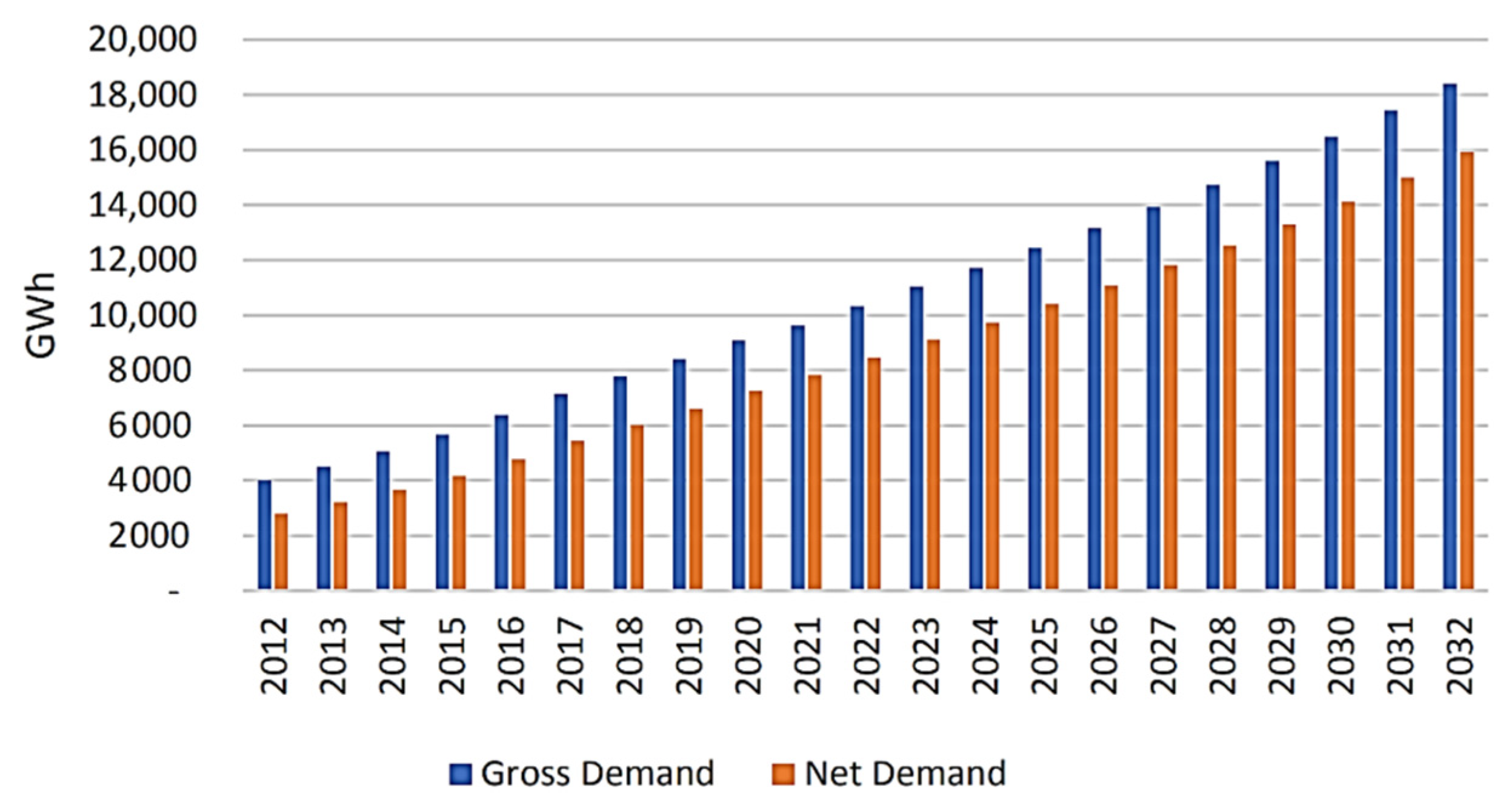
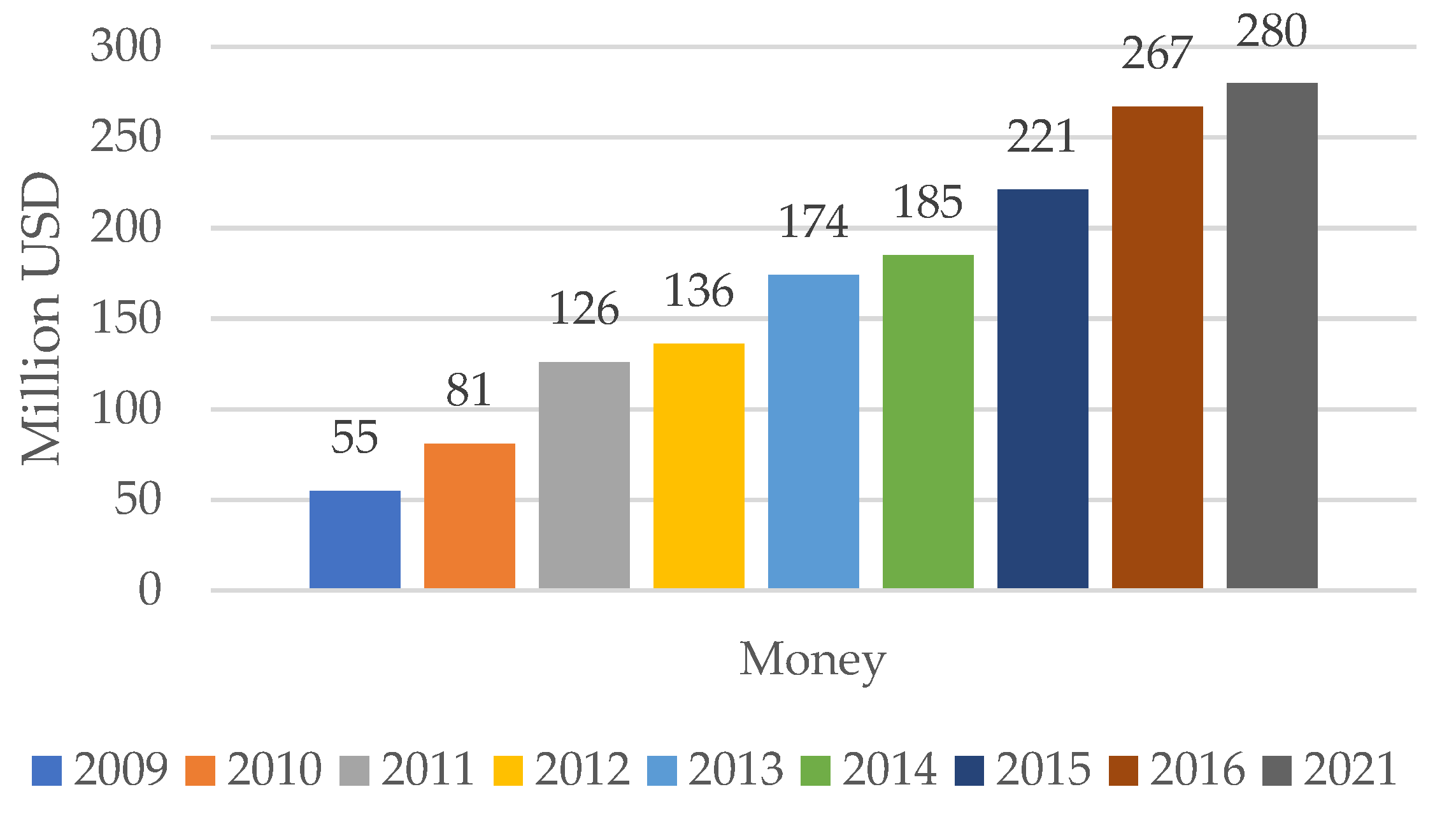
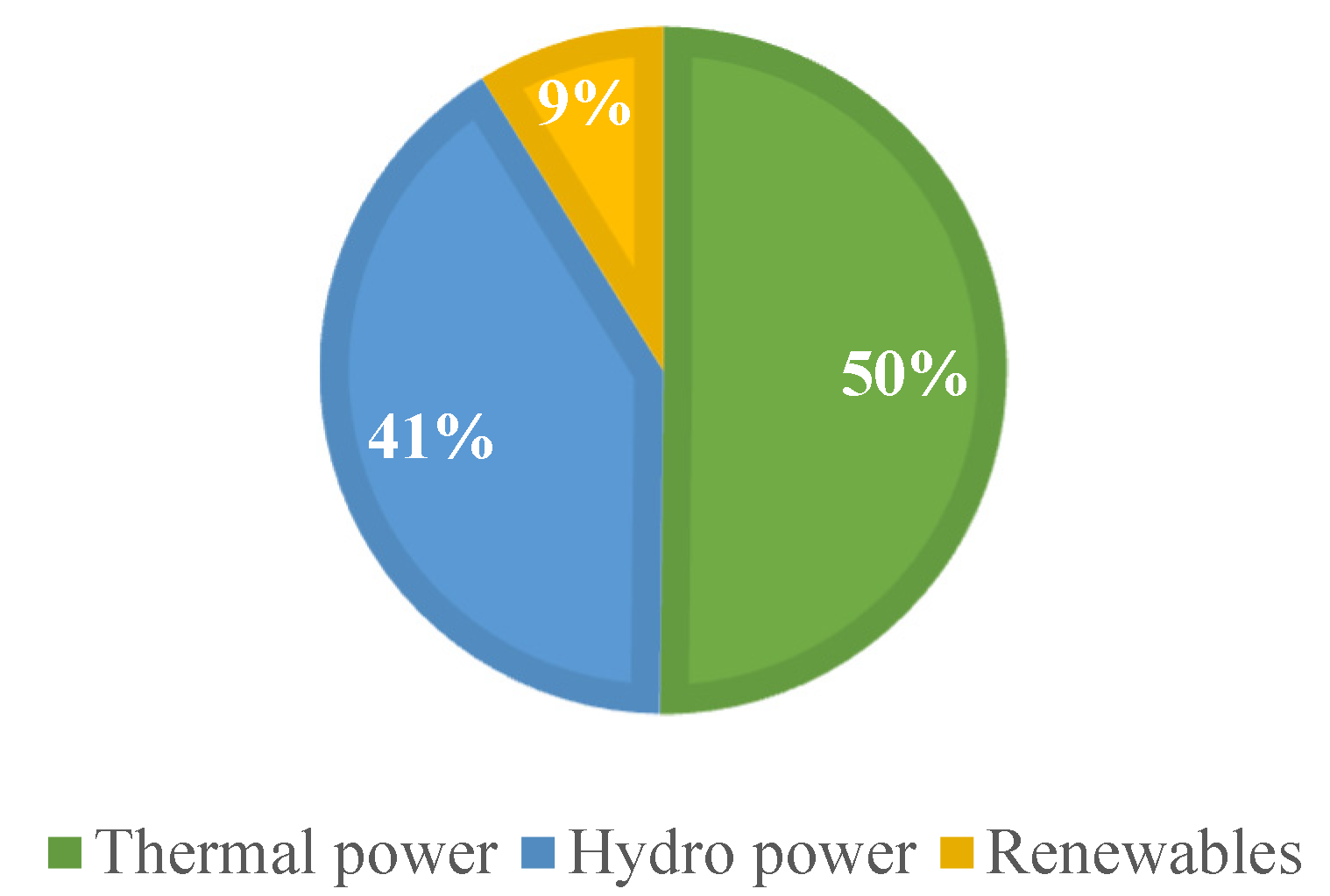
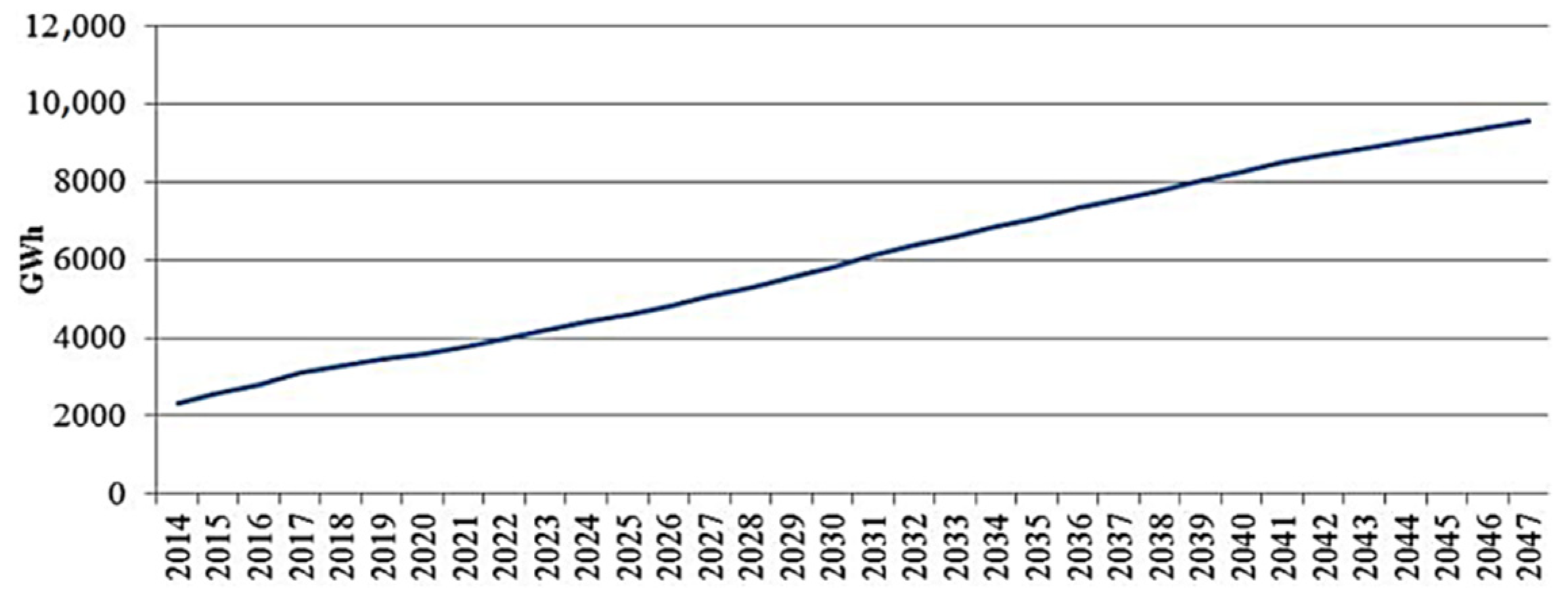
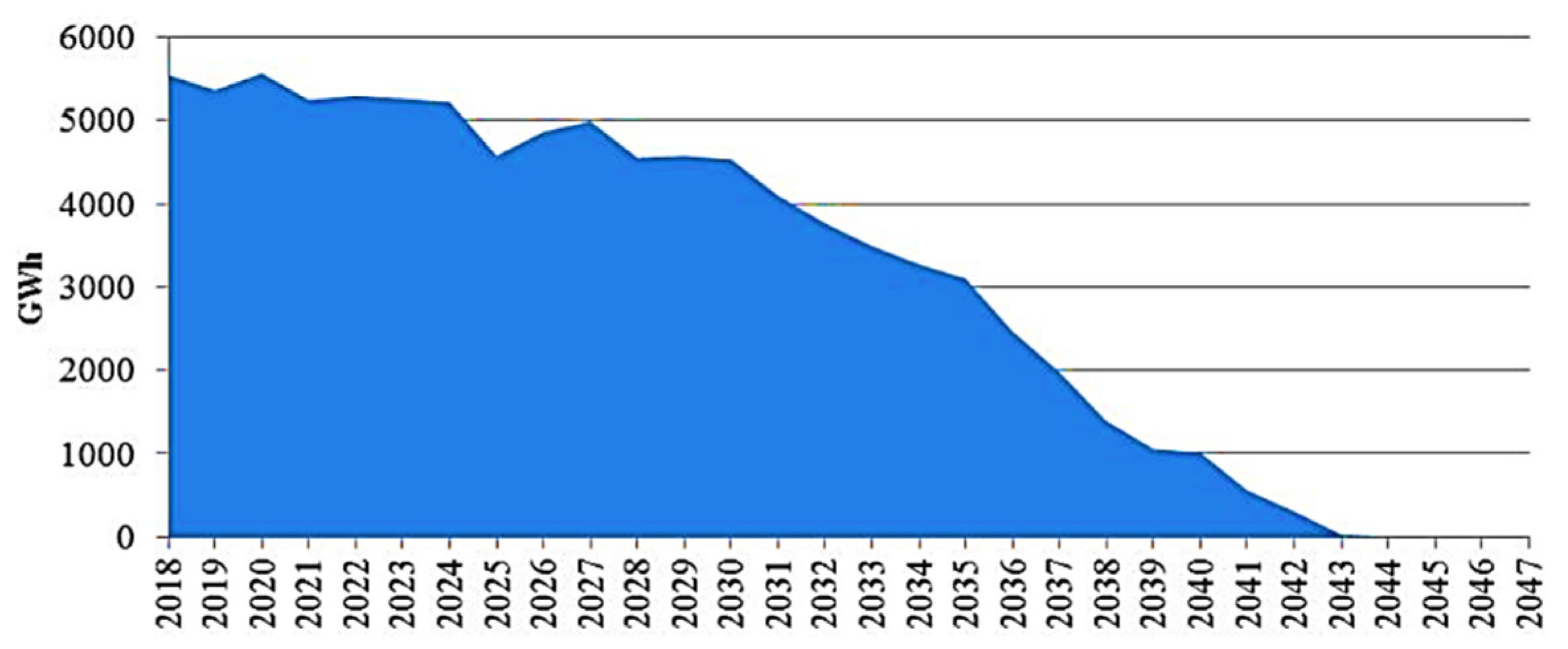
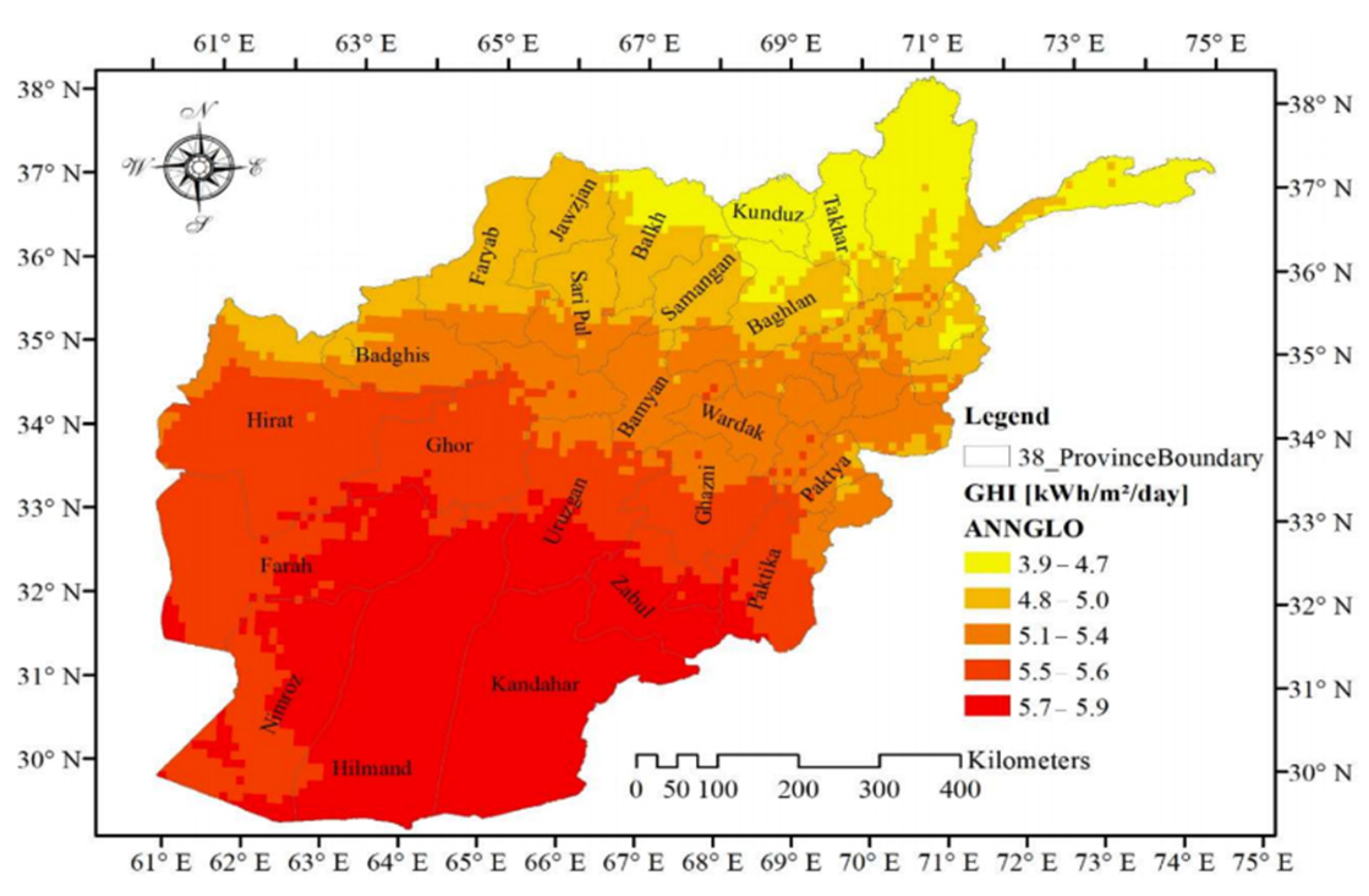

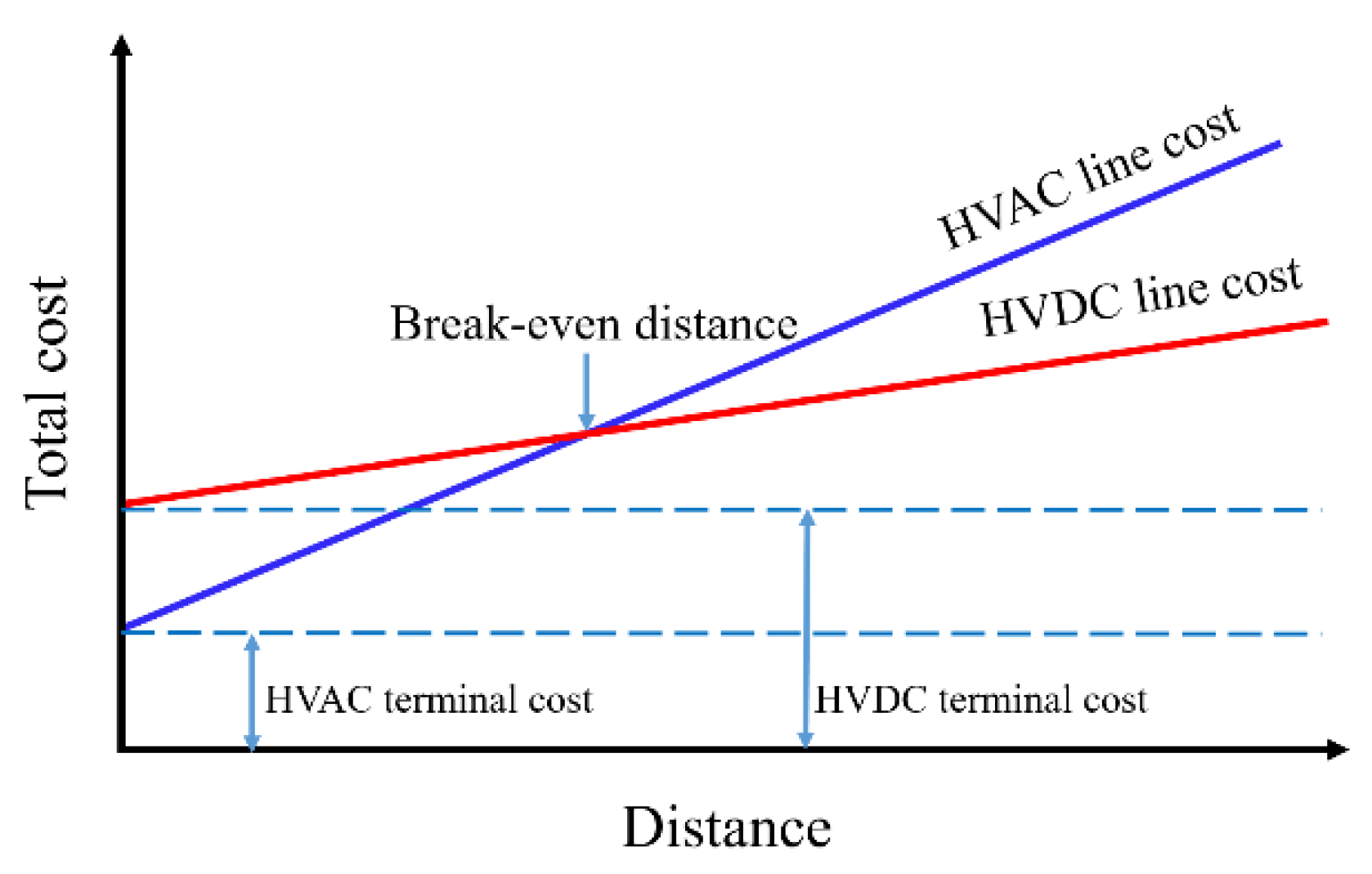
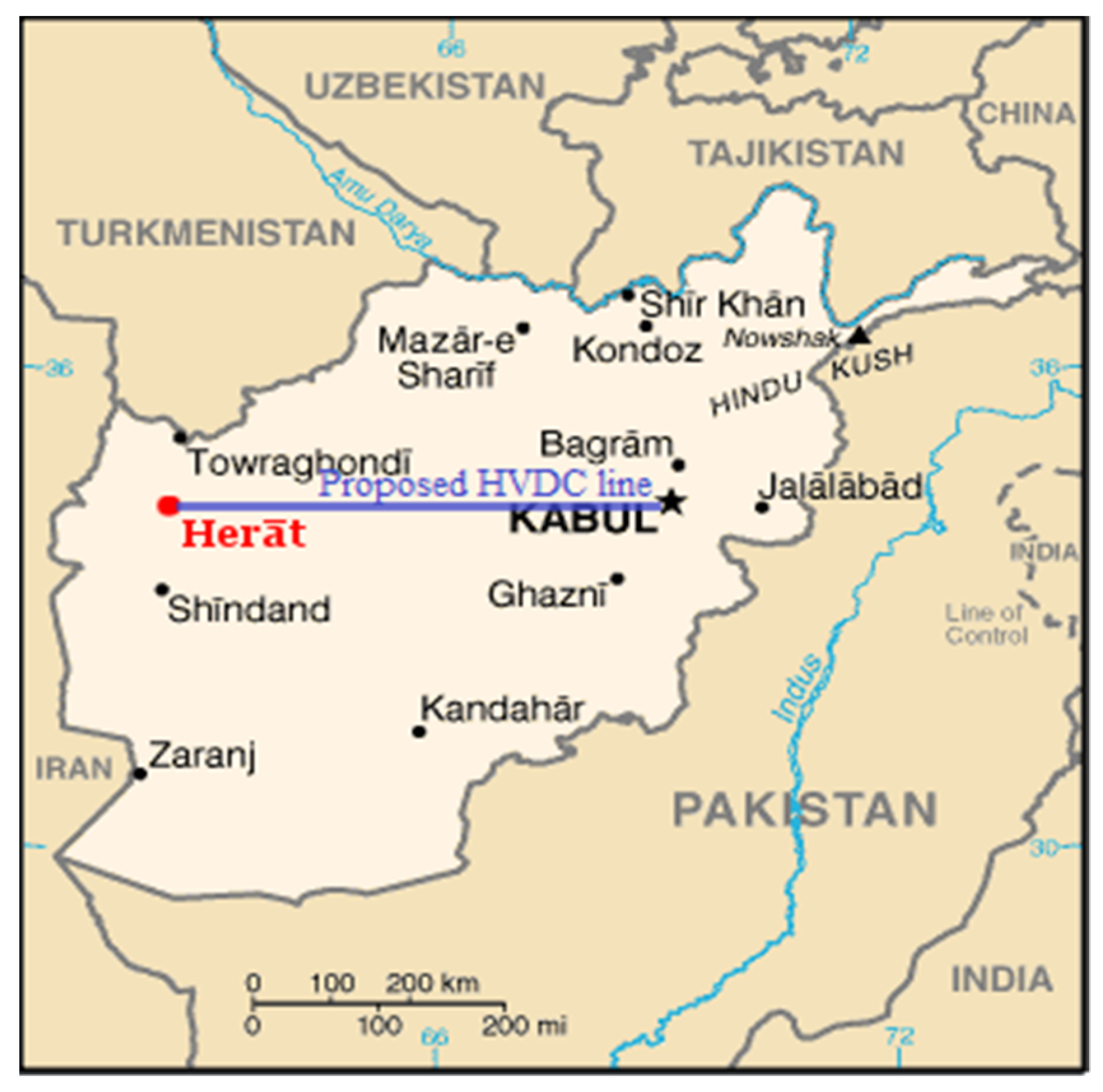
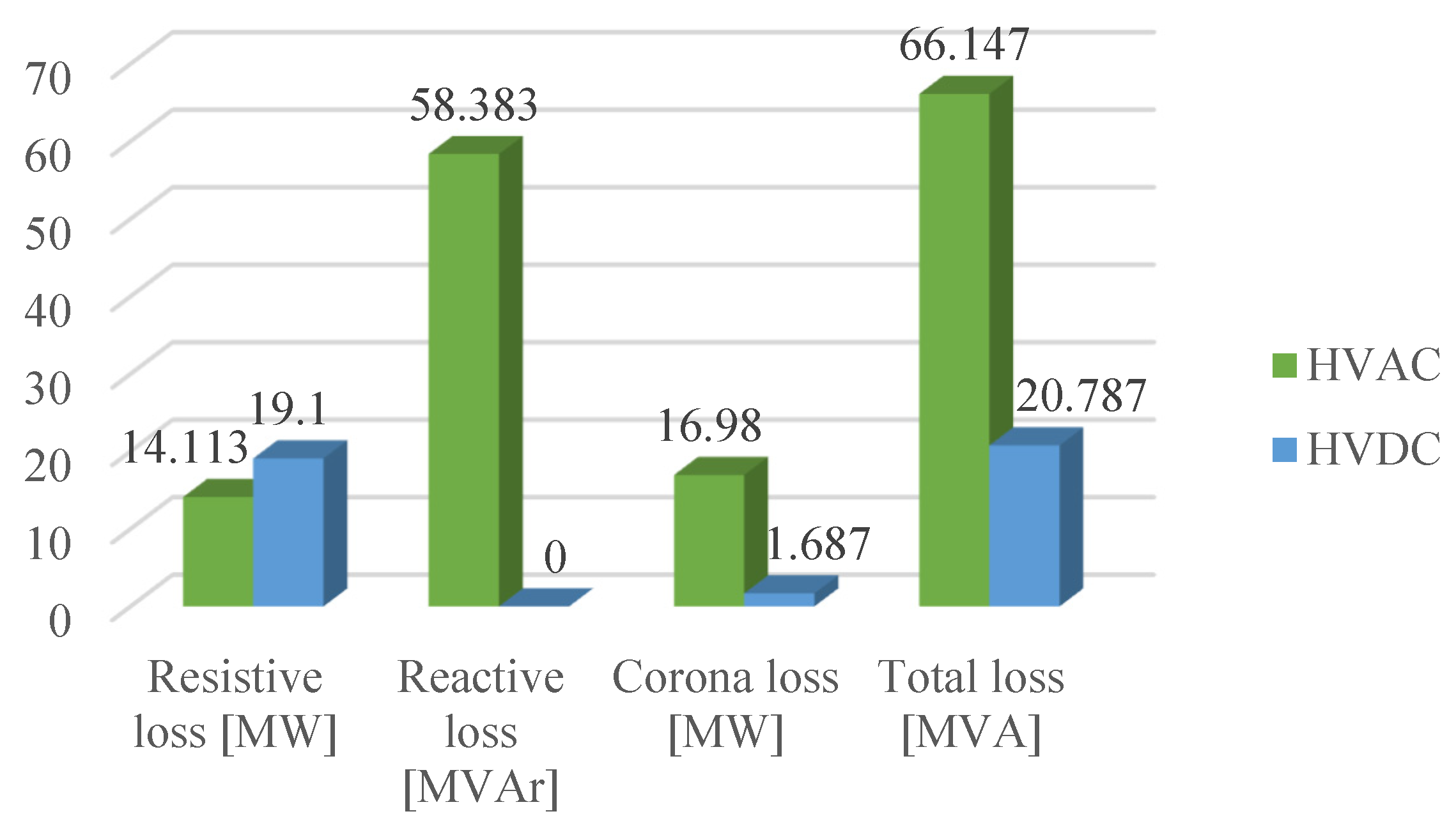

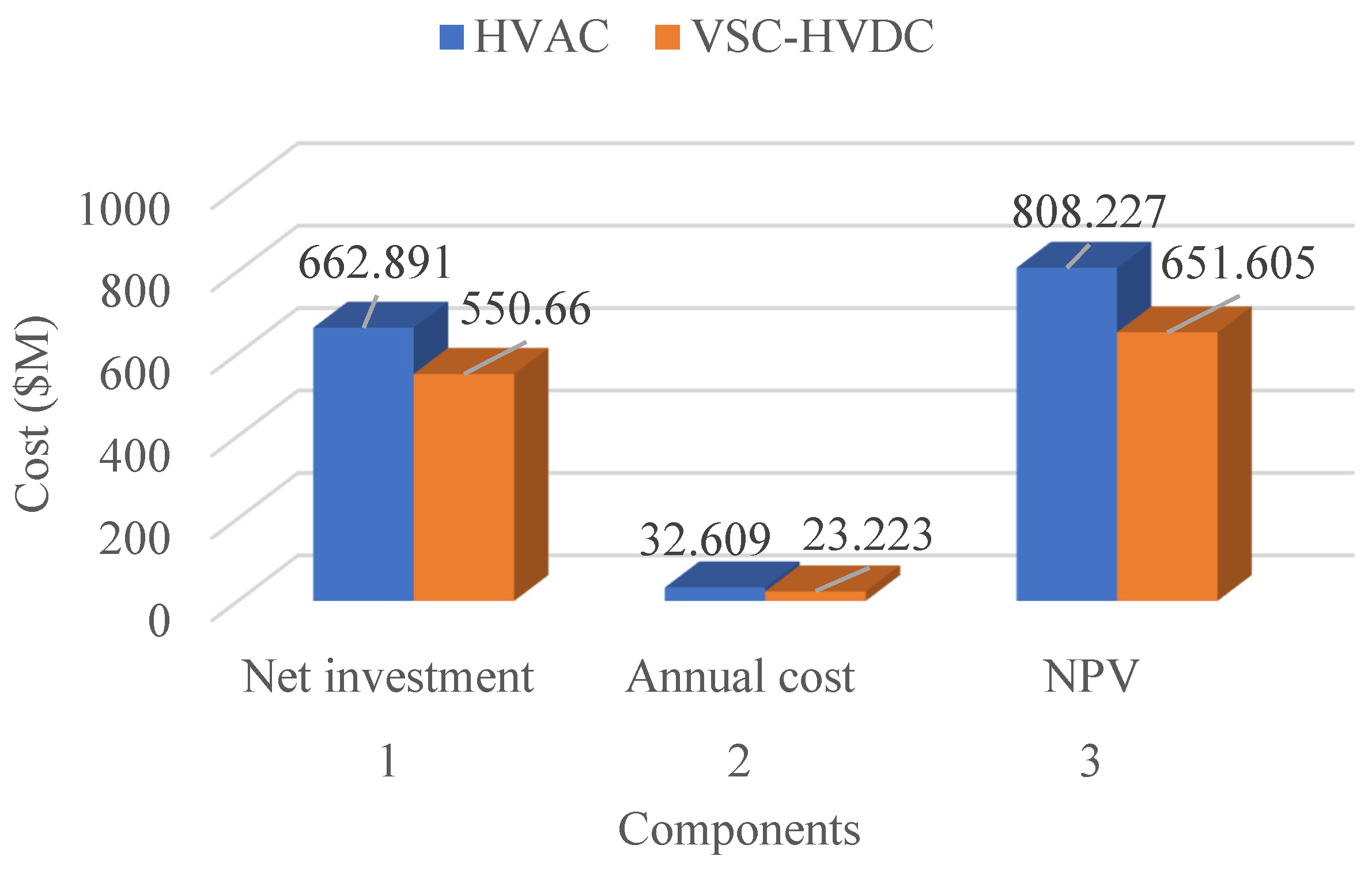
| No. | Characteristics | HVAC | HVDC |
|---|---|---|---|
| 1 | Full control (active and reactive power) | Impossible | Easy |
| 2 | Network connection possibilities | Only synchronized power systems | Any networks (different frequencies and voltages) |
| 3 | Power oscillation damping | No | Yes |
| 4 | Transmission capacity | Low | High |
| 5 | Losses in over break-even distance for the same application | Higher due to the line impedance (R + jX) (5–10%) | Lower due to the absence of capacitive and inductive losses (only R) (2–3%) |
| 6 | Reliability | Low | High |
| 7 | Long-haul transmission stability | Limited | No limit |
| 8 | Efficiency in long-distance | Low | High |
| 9 | Skin effect exist | Yes | No |
| 10 | Space requirement | More | Less |
| 11 | Lifetime | Short | Longer due to the absence of dielectric losses |
| 12 | Noise intensity | High | Low |
| 13 | corona and radio interference | High | Low |
| 14 | Right-of-way (ROW) and visual impact | Could exceed 3 times the HVDC | Narrow |
| 15 | Towers | Larger | Smaller |
| 16 | Charging current issue | Exists | Doesn’t exist |
| 17 | Number of cables/conductors | 3-phase conductors with lower individual ratings | Fewer |
| 18 | Costs in over break-even distance | Higher | Lower |
| 19 | Power transfer capability | Power flow is limited by reac-tance of the line and the operating angle between and :
are the sending and receiving side voltages. due to synchronism relays. | The power flow is only limited by re-sistance of the line : are the sending and receiving side voltages, respectively. Also, power per conductor in HVDC is times HVAC: |
| 20 | Short circuit current limitation | HVAC system contributes to the short-circuit current of connected AC systems. | An HVDC transmission does not contribute to the short circuit current of the interconnected AC system. |
| No. | Attributes | CSC-HVDC | VSC-HVDC |
|---|---|---|---|
| 1 | Switching device | Thyristor valve | IGBT valve |
| 2 | Commutation and its frequency range | grid-commutation, 50–60 Hz | Self-commutation, Up to a few kHz |
| 3 | Power-flow reversal mechanism | Voltage polarity reversal (slow, causes current stress) | Current direction reversal (fast, adds more reliability) |
| 4 | Converter station size | Larger | Smaller (25–40%) |
| 5 | Independent control of active and reactive power | No | Yes |
| 6 | Reactive power demand | 50–60% of rated active power | None |
| 7 | Typical system losses | 2.5–4.5% | 4–6% |
| 8 | Filters requirements | High (Expensive) | Low |
| 9 | Inherent reactive power control and Grid Support | No (discontinuous control (switched shunt banks)) | Yes (continuous control (advanced PWM switching technic, and can support reactive power to the grid)) |
| 10 | Dynamic response | Faster | Slower |
| 11 | Black-start capability | No | Yes |
| 12 | AC side fault handling capability | Lower (Line-Frequency Dependent) | Higher (MVAR support/black Start) |
| 13 | DC side fault handling capability | Higher (DC reactor/short-circuit failure) | Lower (high di/dt rate) |
| 14 | AC and DC side harmonics | Higher | Lower |
| 15 | Maximum available rating | 12,000 MW/±1100 kV | 2000 MW/±500 kV |
| 16 | Multi-terminal HVDC suitability | Limited | Highly suitable |
| 17 | Stations cost | Lower | Higher |
| 18 | Scheduled maintenance | Typically < 1% | Typically < 0.5% |
| 19 | AC connections | Limited to medium and high capacity circuits. | Electrically can be connected to weak networks |
| Region | Number of Projects | HVDC Line/Cable Length (km) | Total Capacity (MW) |
|---|---|---|---|
| North America | 29 | 66,942 | 75,150 |
| Europe | 23 | 5772 | 20,220 |
| China and India | 33 | 60,561 | 266,700 |
| Others | 12 | 25,120 | 37,110 |
| Total | 97 | 118,445 | 399,180 |
| No. | Name of the Project | Total Line/Cable Length (km) | DC Voltage Rating (kV) | Power Rating (MW) | Year |
|---|---|---|---|---|---|
| 1 | Hellsjön-Grängesberg | 10 | 180 | 3 | 1997 |
| 2 | Terranora interconnector | 59 | 80 | 180 | 2000 |
| 3 | Eagle Pass, Texas Back to Back | 138 | 36 | 2000 | |
| 4 | Tjæreborg | 4.3 | 9 | 7 | 2000 |
| 5 | Cross Sound Cable | 40 | 150 | 330 | 2002 |
| 6 | Murray link | 177 | 150 | 220 | 2002 |
| 7 | HVDC Troll | 70 | 60 | 80 | 2004 |
| 8 | Estlink | 105 | 150 | 350 | 2006 |
| 9 | NordE.ON 1 | 203 | 150 | 400 | 2009 |
| 10 | HVDC Valhall | 292 | 150 | 78 | 2009 |
| 11 | Trans Bay Cable | 88 | 200 | 400 | 2010 |
| 12 | Caprivi Link | 970 | 500 | 300 | 2010 |
| 13 | HVDC DolWin1 | 165 | 320 | 800 | 2013 |
| 14 | HVDC HelWin1 | 130 | 250 | 576 | 2015 |
| 15 | SydVästlänken | 260 | 300 | 1200 | 2015 |
| 16 | HVDC NordBalt | 450 | 300 | 700 | 2015 |
| 17 | Skagerrak 4 | 244 | 500 | 700 | 2015 |
| 18 | Interconexión Eléctrica Francia-España (INELFE) | 64.5 | 320 | 2000 | 2015 |
| 19 | DolWin2 | 135 | 320 | 900 | 2016 |
| 20 | Zhangbei | 818 | 500 | 3000 | 2019 |
| 21 | Chongqing-Hubei | 1711 | 420 | 5000 | 2019 |
| 22 | Tres Amigas SuperStation | 48.3 | 345 | 5000 | 2021 |
| 23 | Siemens and Sumitomo joint project of India | 263 | 320 | 2000 | 2021 |
Publisher’s Note: MDPI stays neutral with regard to jurisdictional claims in published maps and institutional affiliations. |
© 2022 by the authors. Licensee MDPI, Basel, Switzerland. This article is an open access article distributed under the terms and conditions of the Creative Commons Attribution (CC BY) license (https://creativecommons.org/licenses/by/4.0/).
Share and Cite
Ludin, G.A.; Nakadomari, A.; Yona, A.; Mikkili, S.; Rangarajan, S.S.; Collins, E.R.; Senjyu, T. Technical and Economic Analysis of an HVDC Transmission System for Renewable Energy Connection in Afghanistan. Sustainability 2022, 14, 1468. https://doi.org/10.3390/su14031468
Ludin GA, Nakadomari A, Yona A, Mikkili S, Rangarajan SS, Collins ER, Senjyu T. Technical and Economic Analysis of an HVDC Transmission System for Renewable Energy Connection in Afghanistan. Sustainability. 2022; 14(3):1468. https://doi.org/10.3390/su14031468
Chicago/Turabian StyleLudin, Gul Ahmad, Akito Nakadomari, Atsushi Yona, Suresh Mikkili, Shriram Srinivasarangan Rangarajan, Edward Randolph Collins, and Tomonobu Senjyu. 2022. "Technical and Economic Analysis of an HVDC Transmission System for Renewable Energy Connection in Afghanistan" Sustainability 14, no. 3: 1468. https://doi.org/10.3390/su14031468
APA StyleLudin, G. A., Nakadomari, A., Yona, A., Mikkili, S., Rangarajan, S. S., Collins, E. R., & Senjyu, T. (2022). Technical and Economic Analysis of an HVDC Transmission System for Renewable Energy Connection in Afghanistan. Sustainability, 14(3), 1468. https://doi.org/10.3390/su14031468











